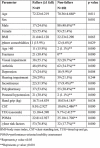Assessment of Fall Risk in Elderly Rural Population
- PMID: 35261662
- PMCID: PMC8897804
- DOI: 10.26574/maedica.2021.16.4.609
Assessment of Fall Risk in Elderly Rural Population
Abstract
Background: Fall risk assessment is an essential component of a comprehensive fall reduction and prevention program. Fall risk assessment is done to identify patients' risk for falls and ultimately prevent falls from occurring. The aim of the study was to identify the risk factors for fall in the elderly population. Methods:This study included 250 elderly patients > 60 years (105 males, 145 females) attending Medicine OPD in a tertiary care hospital. Detailed history including the previous h/o falls, medication history elicited and divided study subjects into two groups: fallers and non-fallers. Cardiovascular, neurological, and musculoskeletal system examinations were done. Handgrip, 30 seconds chair standing test (CST), "timed up and go" test (TUG), and performance-oriented mobility assessment (POMA) were performed. Results:The prevalence of falls in our study was 27.6%. The mean age of fallers was 72.22±6.219 years (P 0.002). Females had significant falls compared to males (p < 0.001). In binary logistic regression, age >80 [OR-3.8, CI (1.8-8.1); p 0.016], female gender [OR-19.2, CI (3.03-122.2); p 0.002], visual impairment [OR-8.9, CI (1.4-55.4); p 0.019], postural hypotension [OR-59.8, CI (3.3-1.07); p 0.006] and presence of more than three risk factors [OR-9.6, CI (4.6-2.01); p 0.000] were significantly associated with fall in our study. Conclusion:Falls among older people were common, especially among individuals aged over 80. Females were more prone to fall. The number of risk factors, visual impairment, and postural hypotension increased the fall risk. Simple clinical assessment can identify high-risk patients.
Figures
Similar articles
-
Performance-Oriented Mobility Assessment test and Timed Up and Go test as predictors of falls in the elderly - A cross-sectional study.J Family Med Prim Care. 2022 Nov;11(11):7294-7298. doi: 10.4103/jfmpc.jfmpc_1294_22. Epub 2022 Dec 16. J Family Med Prim Care. 2022. PMID: 36993044 Free PMC article.
-
The Aachen Mobility and Balance Index to measure physiological falls risk: a comparison with the Tinetti POMA Scale.Eur J Trauma Emerg Surg. 2016 Oct;42(5):537-545. doi: 10.1007/s00068-016-0693-2. Epub 2016 Jun 10. Eur J Trauma Emerg Surg. 2016. PMID: 27287271
-
A modified fall risk assessment tool that is specific to physical function predicts falls in community-dwelling elderly people.J Geriatr Phys Ther. 2014 Oct-Dec;37(4):159-65. doi: 10.1519/JPT.0b013e3182abe7cb. J Geriatr Phys Ther. 2014. PMID: 24577358
-
Assessing gait and balance impairment in elderly residents of nursing homes.J Phys Ther Sci. 2016 Sep;28(9):2486-2490. doi: 10.1589/jpts.28.2486. Epub 2016 Sep 29. J Phys Ther Sci. 2016. PMID: 27799676 Free PMC article.
-
Functional Reach Test, Single-Leg Stance Test, and Tinetti Performance-Oriented Mobility Assessment for the Prediction of Falls in Older Adults: A Systematic Review.Phys Ther. 2021 Oct 1;101(10):pzab173. doi: 10.1093/ptj/pzab173. Phys Ther. 2021. PMID: 34244801
Cited by
-
Performance-Oriented Mobility Assessment test and Timed Up and Go test as predictors of falls in the elderly - A cross-sectional study.J Family Med Prim Care. 2022 Nov;11(11):7294-7298. doi: 10.4103/jfmpc.jfmpc_1294_22. Epub 2022 Dec 16. J Family Med Prim Care. 2022. PMID: 36993044 Free PMC article.
-
Meteorological parameters and hospital-acquired falls-A multicenter retrospective study based on 10 years of adverse events reporting system data.Heliyon. 2024 Jul 5;10(13):e34193. doi: 10.1016/j.heliyon.2024.e34193. eCollection 2024 Jul 15. Heliyon. 2024. PMID: 39071631 Free PMC article.
-
Falls and associated risk factors in a sample of old age population in Egyptian community.Front Public Health. 2023 Jan 26;11:1068314. doi: 10.3389/fpubh.2023.1068314. eCollection 2023. Front Public Health. 2023. PMID: 36778572 Free PMC article.
References
-
- Census of India for 1961-2001, NSSO Survey 2004-05 and 2007-08, SRS (Sample Registration System) Statistical Report 2011.
-
- Population Reference Bureau. World population highlights: key findings from PRB’s 2010 world population data sheet. Available at: http://www.prb.org/pdf10/65.2highlights.pdf.
-
- SRS Bulletin (Sample Registration System) October, 2012, Registrar General of India, New Delhi.
-
- Graafmans WC, Ooms ME, Hofstee HMA, et al. Falls in the Elderly: A Prospective Study of Risk Factors and Risk Profiles. American Journal of Epidemiology. 1996;143:1129–1136. - PubMed
-
- Hsu HC, Jhan LJ. Risk Factors of Falling among the Elderly in Taiwan: A Longitudinal Study. Taiwan Geriatrics & Gerontolog. 2008;3:141–154.
Publication types
LinkOut - more resources
Full Text Sources




